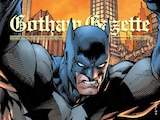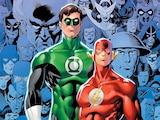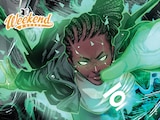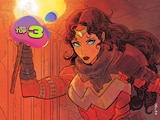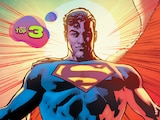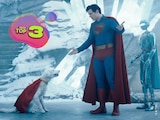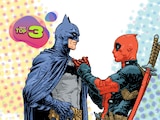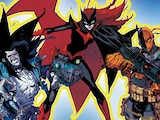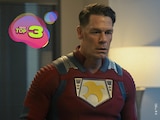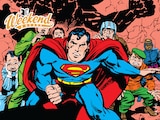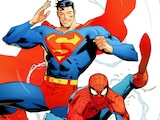For most of us, it feels like Batman has always been there, something that’s not all that surprising considering he made his debut in 1939. Yet, while the Caped Crusader has been around for 85 years now, it’s easy to forget that he was a much different hero when he first splashed onto the scene in Detective Comics #27. The time was a lot different as well, with the world in the throes of the Great Depression and fascism on the rise across the globe. Good and evil felt much more black and white, and one man with the right resources seemed like he could really make a difference.
This earliest version of “the Bat-Man” feels like an entirely different superhero from the Dark Knight of today—and yet, there’s something undeniably compelling about him. Which is why it’s a wonder that we haven’t seen a comic like The Bat-Man: First Knight until now. Inspired by Batman’s Golden Age adventures, this DC Black Label miniseries reinvigorates Bob Kane and Bill Finger’s original superhero for the modern age, taking us on a dark, frighteningly relevant ride by Dan Jurgens and Mike Perkins. It feels fresh, dangerous and unpredictable, suggesting that Batman’s past may have quite a future at DC.
To learn more about The Bat-Man: First Knight’s inspiration and how you balance reinvention with remaining true to the Dark Knight’s roots, we recently spoke to Jurgens and Perkins who discussed bringing Bruce Wayne’s history back to life.

What inspired telling Batman story set in the year that Batman first debuted?
Dan Jurgens: There were several things that spurred my interest in the type of project that The Bat-Man: First Knight has become.
First of all, I’ve always been a fan of that era as it’s filled with incredible change, tragedy and atmosphere. I have an affinity for those old Shadow and Doc Savage pulps, as well as the very first stories of Bat-Man himself. There’s something tremendously compelling about his early appearances and the way the stories reflect the era.
When I was working on Detective Comics #1027 and the “Generations: Fractured” story that led to the Generations: Shattered and Generations: Forged specials, we had a very early Batman as one of our characters. As a result, I began thinking more and more about that version of the character and what could be done with him.
And, of course, there is the era itself. We’re using it to frame Bat-Man in a very particular way.
How does the backdrop of 1939 and the end of the first World War play into the story you’re telling? How much real-world research was involved?
DJ: It’s a particularly fascinating time. By then we were ten years into the Great Depression. The likelihood of a war in Europe, which would eventually erupt as World War II later in the year, was becoming more obvious. There had been a massive pro-Nazi rally for “true Americanism” at Madison Square Garden in February of ’39, which was extremely antisemitic in nature. It was a very divided and charged time, not unlike the world around us now.

Mike Perkins: There was an absolute TON of research that went into this—and that was all important. Dan and I wanted it to feel placed within a specific milieu and that doesn't just come down to setting. Atmosphere plays a massive part. That takes you on to the films of the era and just before—the film noir, the gangster flicks. These are the things that inspired the initial creation of Batman and the contrivances which are the most important aspects to latch onto. Sometimes I would get carried away. I spent half a day looking at the kind of tread that would have been on a boot in '39 as this was important for an iconic Batman shot...but there was nothing more perfect than the classic hobnail. The ramp up to the second World War does play a role in the proceedings and we don't shy away from that.
Which classic Batman stories did you research to prepare for this series?
DJ: This story takes place during the Bat-Man’s first few appearances in Detective Comics, so I really focused on those. The Bat-Man first appeared in Detective Comics #27 and Robin doesn’t show up until Detective Comics #38, almost a year later. Even Alfred doesn’t debut for several more years.
For the purposes of our stories, Bruce Wayne has only been the Bat-Man for a few weeks. It’s very new for him and he’s questioning himself throughout the process. Is this something that’s totally crazy to do? Something reasonable? Can he even survive?
So, we use the era and environment of the time, as well as the tone of his earliest stories in Detective Comics, as our inspiration.
MP: Dan and I went back to the originals—that first run of Batman in Detective. Even so, there were certain aspects we didn't think we could pursue. It was a different world back then and vigilantes played to different rules.

What are some of the differences between this Bat-Man and the contemporary Batman?
MP: The biggest difference, artistically, are the ears. Those beautiful, enlarged, scalloped ears that make such a prefect silhouette. The interior of the cape is different too—a light blue against the black of the outside. Beautifully graphic. The purple gloves that only go up to the wrists and that big yellow utility belt.
Speaking of utilities, there are no Bat-tools. He carries a rope and some smoke pellets. There's no Batcave. There's no Alfred—and the manor is a mess because of that! There's almost no Batmobile, apart from the distinctive red roadster that appeared in those early issues. This guy likes to keep to the shadows and it's important to play with those shadows.
DJ: We have gotten to the point where Batman is incredibly, almost impossibly capable. The array of devices, tech and weaponry he has access to is second-to-none. For him, even space travel is easily achieved.
Our Bat-Man is just the opposite. He has several cars, a garage and ad-hoc lab as well as a grasp of criminal science as it existed at the time. When I first explained this to Mike, I used the phrase “Batman unplugged.”
What can you say about the threats the Bat-Man deals with in this story? How is it different from the type of story readers expect from current Batman stories?
DJ: The earliest Batman stories were somewhat reminiscent of the pulps, which tended to focus on more down-to-earth types of villains.
For our story, there is a mysterious background character in Gotham City who wants to use the poor economic conditions, societal discord and overall sense of dissatisfaction and chaos to refashion the city to his liking. He knows the impending war will change everything and eventually come to America’s shores, and he hopes to exploit that for his own purposes. To do that, he creates some powerful allies that serve as tough and potentially lethal opponents for the Bat-Man.

MP: There are no costumed villains in this. It was a conscious decision as we wanted to focus on the Bat-Man. If the Joker appeared, then it would have become a Joker story. In those initial stories in '39, Batman dealt with gangsters, crooked politicians and mad scientists. I think we run the gamut of them in this series!
What has it been like writing and drawing a story for DC Black Label and using the freedom offered by that label?
MP: It's been absolutely wonderful. I've been playing around with the grayscale techniques a little more and that certainly pushes that atmosphere to the fore. The actual size of the board becomes a factor too. I was chatting to a fellow artist about the larger boards and he said, "That's great! You can just slap the ink around." I replied, "No! I'm actually putting in MORE detail!"
DJ: I think the greatest thing that Black Label offers is the chance to explore and expand on thematic elements that might not be as sustainable in a monthly type of book. With the larger page count, we can slow things down a bit to explore things in depth. Readers expect a more nuanced approach to storytelling.
It also gives Mike more room to play with storytelling techniques, as well as the time to do the research necessary to capture the era. His work on this is beyond remarkable—just stunning to look at.

Do you have a favorite page from issue #1?
MP: Whooof! I don't know if that's possible! It's been a phenomenally fun project to work on and I've learnt so much—about the year, the Bat-Man and my approach to art itself!
Perhaps it's the opening...or the ride through Gotham in Bruce's Alfa Romeo...or maybe that iconic splash...or the manor house... Oh wait, perhaps Blackgate Prison or THAT cliffhanger!
What was the balance of telling a story true to the time period, but also making it modern for today’s audience?
MP: That's always a consideration and a concern, but I think we've accomplished it. Mike Spicer, our colorist, has helped immensely with that and was very patient with us at the beginning. Initially I saw the work in sepias and blues, but after a few pages, it all began to feel the same and too much like a constant flashback. The past was vivid! I knew I could count on Mike to do what he does best.
DJ: For us, the idea of balance is built around the concept of parallels between then and now. There are some clear and obvious differences, of course. But at the same time, there is enough in common that aspects of this story will definitely relate to things we’re seeing and experiencing now.
The Bat-Man: First Knight #1 by Dan Jurgens, Mike Perkins and Mike Spicer is now available in print and as a digital comic book.

